
Spaced Repetition — The Study Technique That Helps Students Remember Longer
Many students struggle with forgetting information shortly after studying, especially when relying on traditional methods like rereading or highlighting. Spaced Repetition offers a science-backed solution. It is a learning technique that strengthens memory by reviewing material at increasing intervals. Today, students commonly use digital flashcards, PDF study sheets, and spaced-review templates, often organizing their files with tools such as PDFmigo.com.
What Is Spaced Repetition?
Spaced repetition involves reviewing information at scheduled intervals, timed precisely before the brain begins to forget. Instead of cramming material in one session, students revisit knowledge repeatedly over days and weeks, building deeper retention.
A typical spaced repetition schedule looks like:
- Day 1 — Learn new material
- Day 2 — First review
- Day 4 — Second review
- Day 7 — Third review
- Day 14 — Fourth review
- Day 30 — Fifth review
The Science Behind Spaced Repetition
The method is based on the Forgetting Curve, discovered by psychologist Hermann Ebbinghaus. His research showed that people forget new information rapidly unless it is reviewed periodically. Each spaced review strengthens neural connections, enabling the information to stay in long-term memory.
- Up to 70% of information is forgotten within a day
- Memory improves drastically with correctly timed reviews
- Each review extends how long the brain remembers
Why Spaced Repetition Works
1. Long-Term Retention
Students using spaced repetition remember material for weeks or months, not just days.
2. Saves Time
Instead of long study sessions, students spend short, targeted sessions reviewing what matters most.
3. Reduces Stress
A predictable review schedule prevents last-minute cramming and anxiety.
4. Works Across All Subjects
Spaced repetition is effective for languages, science, math, medicine, history, and standardized test prep.
5. Supports Active Recall
Active recall—testing your memory—is the most powerful technique for learning. Spaced repetition strengthens it naturally.
How to Use Spaced Repetition
Step 1: Organize Information
Break material into small pieces, such as vocabulary words, formulas, definitions, dates, or short facts.
Step 2: Review Immediately
The first review should occur within 24 hours of learning new material.
Step 3: Follow a Review Schedule
Use consistent review intervals such as 1 day, 3 days, 7 days, 14 days, and 30 days.
Step 4: Use Active Recall
Cover your notes and try to recall the answer before checking. Testing your brain reinforces memory.
Step 5: Track Difficult Topics
Review harder material more often and easier material less frequently.
Examples of Spaced Repetition in School Subjects
Language Learning
Ideal for vocabulary, grammar rules, and sentence structures.
Medical and Nursing Students
Used for anatomy terms, medication lists, and diagnostic criteria.
Math & Science
Helps reinforce formulas, theorems, processes, and chemical reactions.
History
Helps students remember dates, events, timelines, and cause–effect relationships.
Digital Tools and PDFs for Spaced Repetition
Most students now rely on digital formats such as flashcards, online quizzes, and PDF study sheets. Teachers often distribute spaced-repetition worksheets in PDF format. Before midterms or finals, students frequently merge these worksheets into a single study booklet using tools like Merge PDF.
Creating Your Own Spaced Repetition System
Method 1: The Box System
Assign review intervals to five boxes (daily, every 2 days, every 4 days, weekly, biweekly). Move cards forward when remembered and backward when forgotten.
Method 2: The Interval Chart
Create a chart with review dates for each item—1 day, 3 days, 7 days, etc.
Method 3: PDF Review Packs
Students often maintain a library of spaced-repetition PDF sheets. Before tests, they combine them into one organized study file using tools available at PDFmigo.com.
Cramming vs. Spaced Repetition
| Cramming | Spaced Repetition |
|---|---|
| High stress, last-minute studying | Low stress, predictable schedule |
| Short-term memory only | Long-term retention |
| Fast forgetting | Slow forgetting |
| No structure | Clear learning plan |
Final Thoughts
Spaced Repetition is one of the most effective learning strategies ever developed. It strengthens memory, reduces stress, and ensures long-term retention. Whether you are studying vocabulary, formulas, dates, or scientific concepts, this method will transform the way you learn. When paired with digital study materials and organized PDF systems, spaced repetition becomes an essential tool for academic success.


